Given I began last week’s post to you with a flourish of colours so evocative of this rich time in summer’s season, I thought to begin this week with the polar opposite…a bounty of dried seed heads on the stem, so diverse in shape, detail and character…it’s almost a question of ‘how many shades of brown’? How they crackle…and pop if you press some varieties to release the tiny seeds from their casing - especially the nigella pods, that when fresh are reminiscent of hot air balloons aloft.
So began my gardening Sunday…with inside, rather than outside work for a change! The time had simply come for that repository of seed I’ve been collecting these past weeks and months to be ordered. Their accumulation though, makes for such a beautiful display; and although I know I ought to deal with them all more efficiently as they come in - sort and store them in a cool, dark, dry place; I have to confess that more often than not, that just doesn’t happen! Then at the eleventh hour (with an event fast approaching) the need to prepare the Dairy space afresh is the prompt required to spur me into action! This happens every year…and every year (so far anyway!) the seeds seem to germinate when the time comes despite their poor storage; and against all odds, somehow the Dairy gradually becomes spider web and dust free too!
So Sunday was a full on inside wheelbarrow day - such was the scale of my annual clean up! I carted the previous ‘insurance policy’ seed on the stem to the compost, and replaced it with this season’s stems, which now either hang for fun at the Dairy windows or, more sensibly, is stored in paper bags and glass jars.
All of it though, awaits its turn to meet with soil; for the time is fast approaching - random pop-ups are telling me so. This week I’ve discovered three little Red Elk Mustard seedlings, newly germinated in the kitchen garden paths. I’ve even picked off and eaten some of their tiny new leaves on my rounds - a taste that hasn’t met my tongue in a good many months. How thrilling!
And so…taking those little plants as my guide, I’m casting a few experimental seeds about to see what occurs. There’s plenty of time ahead, but a few random sowings can do no harm. Already (I think I mentioned a couple of weeks ago) I’d taken some mature heads of parsley seed on the stem, and laid them down where I hope to make the next row of parsley; and done the same with a load of land-cress stems. Whilst I’ve yet to spy a newly germinated parsley seedling, I have spied a tiny land-cress or two popping up! As I was storing away those stems of all kinds in the Dairy…tying some into pretty bunches and cutting others to store in containers, it was inevitable odd ones got left behind…on the table at which I was working and scattered on the floor…so I swept them up and tossed them into the garden. Random sowings…to create a random effect.
In a similar vein…this little spot at the top of the kitchen garden path should begin to swell in volume as the early autumn approaches: a clutch of Amaranth left behind on weeding out its neighbours, will create a random clump of height and autumn colour, with giant pumpkin leaves swirling around its feet. At least that’s the aim! Sometimes it works, sometimes not. Amaranth has such a mind of its own…if I try to sow it specifically I can almost guarantee it won’t work…and this little clump is close enough to where I’d like it to be!
I expect this will be the last time we see this section of path for awhile! We can check in in a few weeks to see how its going…
Because the pumpkins are on the move! It’s years since I began sowing them under the citrus trees, inside the tomato stake fence. Beginning them under the citrus trees means I can keep their roots watered and also give their fragile beginnings some protection from the fierce early summer sun; yet give them plenty of space to romp once they’re established. From this moment on (well…all being well!) romp they will!
How I love when the pumpkin foliage truly gets a move on…as the large, figured leaves forge their way with great determination. They’ll soon be floating gently on the breeze. I know many peeps already have pumpkin vines of immense size and fruit ‘set’, but our peculiar little microclimate seems to dictate our pumpkins grow and form later than those in many other areas. In the same way our tomatoes ripen late. I can’t really explain it. Metres above sea level, lie of the land…it just is what it is…there’s no point fretting! What will be, will be…
The tomatoes are coming in at a pace now…at this rate I’ll need to start preserving them some way or another! Whilst the pumpkins do their own thing in their own good time, I do own the lateness of tomatoes being of my own making. It’s because I believe in growing a strong plant in the early stages - and so direct all their early energy into healthy stems before allowing them to put that energy into flowers and fruit production. I’m in no particular hurry for them - they fruit late into the season here, so our eating habits simply work around their timing. And you know I grow them from saved seed, so I don’t begin with well established seedlings from the nursery…I wait for my own sowings to catch up with the season as it unfolds.
When we were nearing the final shoot day for the book all those years ago, I recall my editor sending a slightly panic-stricken message that January, telling me we had no photographs of tomatoes. “I know” I replied. “But we will…they’re coming” I stated with great conviction. And they did! (Phew!!). And when they did, Daniel captured the most beautiful photograph of them! It’s on page 242 if you have a copy of The House and Garden at Glenmore! They fill the full page that announces the Late Summer / Early Autumn recipe pages; where in the book, just as in last week’s post; their arrival (along with the aubergines and figs and grapes and all the other beauties of this late part of the season) heralded a change of colour…on our plates, in the garden…indeed in the very daily light and atmosphere.
The tomato in the image above is a ‘Hungarian Heart’. It’s the first of that variety to begin ripening this year (how apt it should do so on Valentine’s Day!). As I’ve mentioned so many times before, tomatoes require patience. Over the years one of the most commonly asked questions I receive is “why don’t my tomatoes ripen”? “Oh but they will” is always my reply. You just need to give them time. It’s taken this one a long time to reach this point. Remember I sowed the seeds in July? It’s a long road for a tomato…what’s a few more days?
And now I’m wondering if I really ought to pick this one! I know it’s not quite ready but I’m usually in the habit of picking at first blush, as tomatoes ripen perfectly well on the kitchen bench and are certainly safer there than on the vine! I often wonder if ‘vine ripened’ is nothing more than a marketing ploy…a descriptor that looks good on a menu and in the shops. I may have to go and pluck it before reaching the end of this post…I don’t want to jinx it!
Seed production and collecting, is an ongoing part of the growing sequence, if you choose to practice full cycle gardening. The term is one I seem to have coined (for want of a better description). I don’t recall ever reading about it…it’s just the way I’ve been gardening for a good long time. It partly came about because I find the flowers of vegetables to be particularly enchanting - they tick all my wild and romantic boxes (as I know I’ve said about fifty million times before!). As well as being excellent companions in the garden, bringing in all the good bugs (which I also know I say on repeat…I do often feel like a broken record! I wonder if future generations will even know what that expression actually means? That just occurred to me…sorry…! Now I have visions of my parents’ old gramophones and piles of brown-paper covered records in my head!). Where was I?
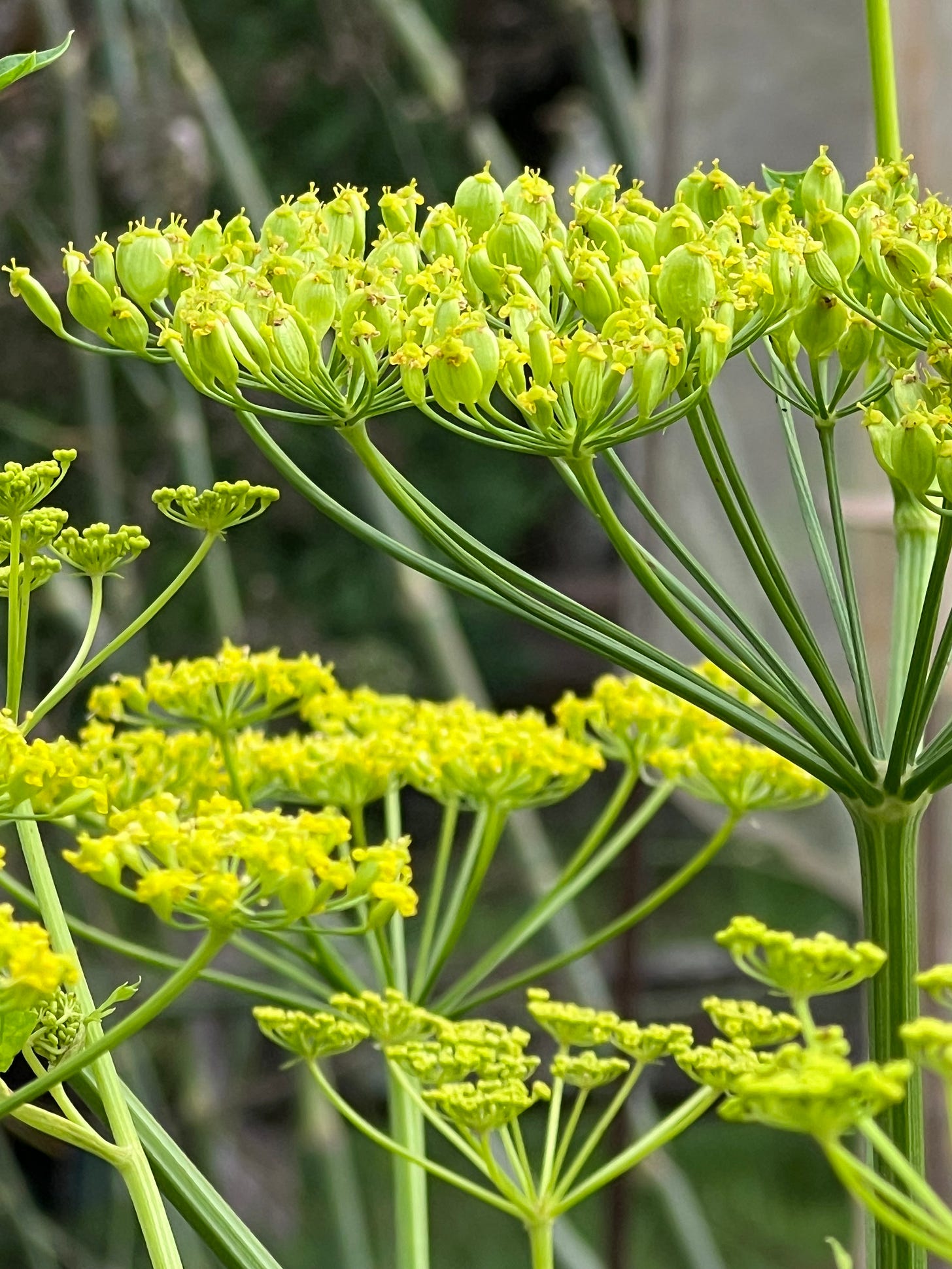
Yes…food security. On a serious note…encouraging seed to form is a way of ensuring food security, which surely must be one of the most significant concerns for us all? The fact I save seed, means I can share it around. I’m happy to share my ‘seed bank’ with anyone who asks; and spread it around I surely do.
In allowing many plants to self sow, they’re inclined to do so at all different times…in their own time and on their own terms.
These parsnip flowers are a good example. Down the back, a clump of self sowers that looked so enchanting as they flowered during late spring under the Quince tree, have long since formed their seed, which dried right there on the stem. I’ve subsequently folded their stems over, tipping their heads towards the earth and causing ripe seed to spill for a repeat performance next year. I could just as easily have saved some of those heads (I still could…many are clinging on for dear life and have not yet made contact with the soil below). But I’d already saved another good few heads that flowered before those ones…and it’s those I’ll sow as soon as I reckon the time is right. Now it’s the turn of the ones I left behind in the row we’d mostly eaten our way through during the late winter and spring that have bolted to newly formed flowers, with fresh seed on some beginning to form…ensuring a continuous cycle of beauty to behold and seed to save. I don’t think Glenmore is ever likely to be without parsnips growing somewhere in the garden!
To be honest, I can’t imagine kitchen gardening any other way than full cycle to full cycle.
As a little aside (just because this thought always pops into my head when I do bend a stem of dried seed heads over) let’s take a little tangent, because the purpose of this writing afterall, is to share information that might otherwise pass new gardeners by.
I’m guessing that many of you, like me, didn’t grow up with an example of gardening to absorb naturally. And, if you’re at all like me, it’s quite possible you learn the best things in life almost by osmosis! So to emphasise the point I’ve made above about ‘turning stems over’ which may still sound elusive to a new gardener…
Imagine a much younger me…the garden at Glenmore only just begun (or hardly even…). Oh but I was planning! With Clemmie mostly fixed in position on my hip…I think this was on our first trip back to the UK since she was born and we went to visit everyone…Larry’s family, friends and…as many gardens as we could in between….all the ones I’d been reading about in the flood of books I’d accumulated since we did arrive at Glenmore! Lucky for us, family and friends were / are well scattered and so there were plenty of gardens we could visit enroute between them all. On reflection…were those gardens even remotely relevant? It matters not, for they inspired, and for the first time, because I had the space and opportunity to actually make a garden, I wasn’t just drinking in the beauty, but paying proper attention to the myriad principles and nooks and crannies underpinning them.
Even so, the most important lessons often arrive…by chance. And to be honest? As a general rule they’re more inclined to arrive via the gardens of friends…whose gardens are inclined to be beautiful, well tended and loved, yet not quite so well groomed as those open to the public. And so it was that we stayed a couple of nights with very dear friends. I think I mentioned once before (same visit) that Sarah introduced me to a book that for awhile became my bible: The Royal Horticultural Society’s ‘Gardeners’ Encyclopaedia of Plants & Flowers’. On return home, I subsequently bought the Readers’ Digest version for Australia and New Zealand, but I still have the original and all the notes I made on that trip stuffed into its pages.
But it wasn’t just the book, or Sarah’s glorious garden…one she’d inherited from her parents-in-law and was putting her own stamp on…making her own mark, that is responsible for this tangent. It’s this:
As we walked around her garden one fine early autumn day, chatting…as one does, and pausing here and there to admire a flower or watch the path of a fuzzy bumble bee…Sarah intermittently calling to her dogs (in that very specific kind of high pitched and definite manner reserved for the name of a dog who has likely gone off chasing a rabbit instead of staying by its mistress’s side and so is therefore likely a long way off), I recall her reaching in to her herbaceous border and folding over a tall stem - at about half way down its height. And again, as we continued gently on; on repeat. To be perfectly honest, at the time, I don’t think I fully knew what she was doing. Between our topic of conversation that was likely completely unrelated to her actions, the calling of the dogs, the drone of the bees and me keeping an eye on Clemmie who was, at eighteen months old, extremely mobile and as likely to wander off as the dogs; I don’t recall asking what she was doing or why. Her repetitive action was self-explanatory of course, but something I’d never done. At that stage, I’d not yet ever grown a stem of flowers…let alone one that had set seed. Even now, I associate this very action with the English Country House, from another time and era, (though the action is as alive and well today as it ever has been for those in possession of a herbaceous border!). But on the whole, plants that behave in that way are not the ones that grow naturally or particularly well in this country, save in particular pockets (and why should they?).
But veg varieties do! And so it is that each time I fold over a stem, sending its seeds fluttering towards the earth, I think of Sarah, and that vital lesson I learned by observation.
What I gathered that day, came to define the heart of my kitchen gardening practice.
What a tangent! No doubt with time to edit I could have cut it in half! But I hope you’ll find it helpful somewhere along your own gardening line..that it sticks, and you’ll smile when you fold your own stems in half!
Seed aside, it’s been a week of bounty and beauty. The fruits of the Jelly Wine Palm Butia capitata are ripening in great, weighty bunches. I can’t reach them all, stupidly underplanted as that tree is (my own silly fault!) with a succulent I only ever meant to ‘heel in’, in order to plant elsewhere at a later date (now there’s a lesson if ever there was…never leave a succulent lying around for later!).
Beautiful specimen that this one is…it’s going to create havoc down the track…but we’ll just worry about that later! The story of these particular specimens (behind the Agave americana) I know I’ve mentioned before but I’ll come back to another story relating to the owner of that nearby garden one day soon because, it’s from her long life of gardening that I came to another realisation.
But in the meantime I shall leave you with this Hibiscus - whose flowers we have enjoyed at this time of year, every single year of our marriage. That little specimen was our first ever plant purchase for the tiny courtyard of our first little married house in Sydney (before we knew Glenmore even existed). We put it in a pot and though it’s been re-potted a number of times since, it’s still about the same size it was then! I’ve nowhere else for it to go, and it sits here amongst the higgledy-piggledy collection of potted specimens quite happily. The reason we took it home with us that day, was that we both instantly recognised its flower as being the very same colour and variety as the one in Larry’s Pa’s garden in Mallorca…still so vivid in our minds thanks to the multitude of visits in the lead up to our marriage and…subsequent digression to Australia! We had no idea what adventures lay ahead…
Happy Valentine’s Day!
Mickey x
Productive garden notes:
Eating from the garden:
Potatoes, onions, garlic, cucumbers, aubergines, zucchinis, tomatoes, coloured chard and spinach, lettuce, rocket. Figs! Many figs! Jelly Wine Palm fruits. Basil, lovage, mint, rosemary, thyme, chives. Just don’t speak to me about beans!
Going / gone: fennel pollen, fresh fennel seed, micro leaf amaranth, grapes
Seed saving: parsnip, beetroot, spinach, chard, parsley, land cress
Sowing: the random seeds that fell from the seed saving table out of curiosity (see above) but on purpose and direct, still attached to their stems, parsley
Planting: none - too hot
Ornamental garden notes:
Picking for the house: Roses, magnolias, frangipanis, tansy, dahlias, Cottonwood hibiscus and ginger…
Perfumes and aromas: Night scented Jessamine is still on full volume, spilling each evening across the verandah and in through the open windows. Frangipani, magnolia, rose, ginger and fig. The Gardenia thunbergia are less prevalent since that explosion of flowers a couple of weeks ago. Nicotiana in the kitchen garden, pungent tansy and drying fennel too.
Pruning and other: Saturday was filled with the joy of compost turning! It was a terrific turn - much has broken down though there’s still some way to go. I managed to feed in a good amount of blood & bone, chicken manure pellets and to pour in a good amount of cowpat tea. You really didn’t want to see me after all that was done! Then I got to the usual kitchen garden tweaking - tying up etc whereas Sunday was truly all about sorting out the Dairy in preparation for an exciting little event next week. This week began with the most wonderful thunderstorm, enabling me to get Thalia inside to help shift furniture in the Dairy for cleaning and repair work to the stick installation that was falling to pieces on the end wall! Since, the lavender under the iceberg roses at the end of the Dairy has had a good cut back and the same for the row that edges the citrus just outside the kitchen window. The final Phormium in the Borders has been tidied and the orchard trees all weeded; the olives cleared of shoots forming around their base and lower trunks and….a whole lot of random weeding, because weeds and stormy weather go hand in hand!

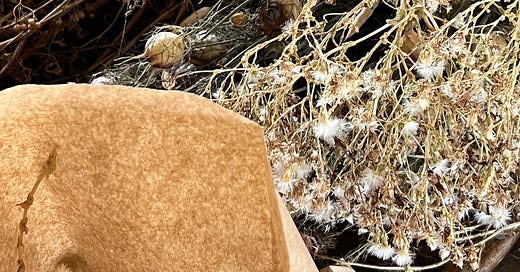



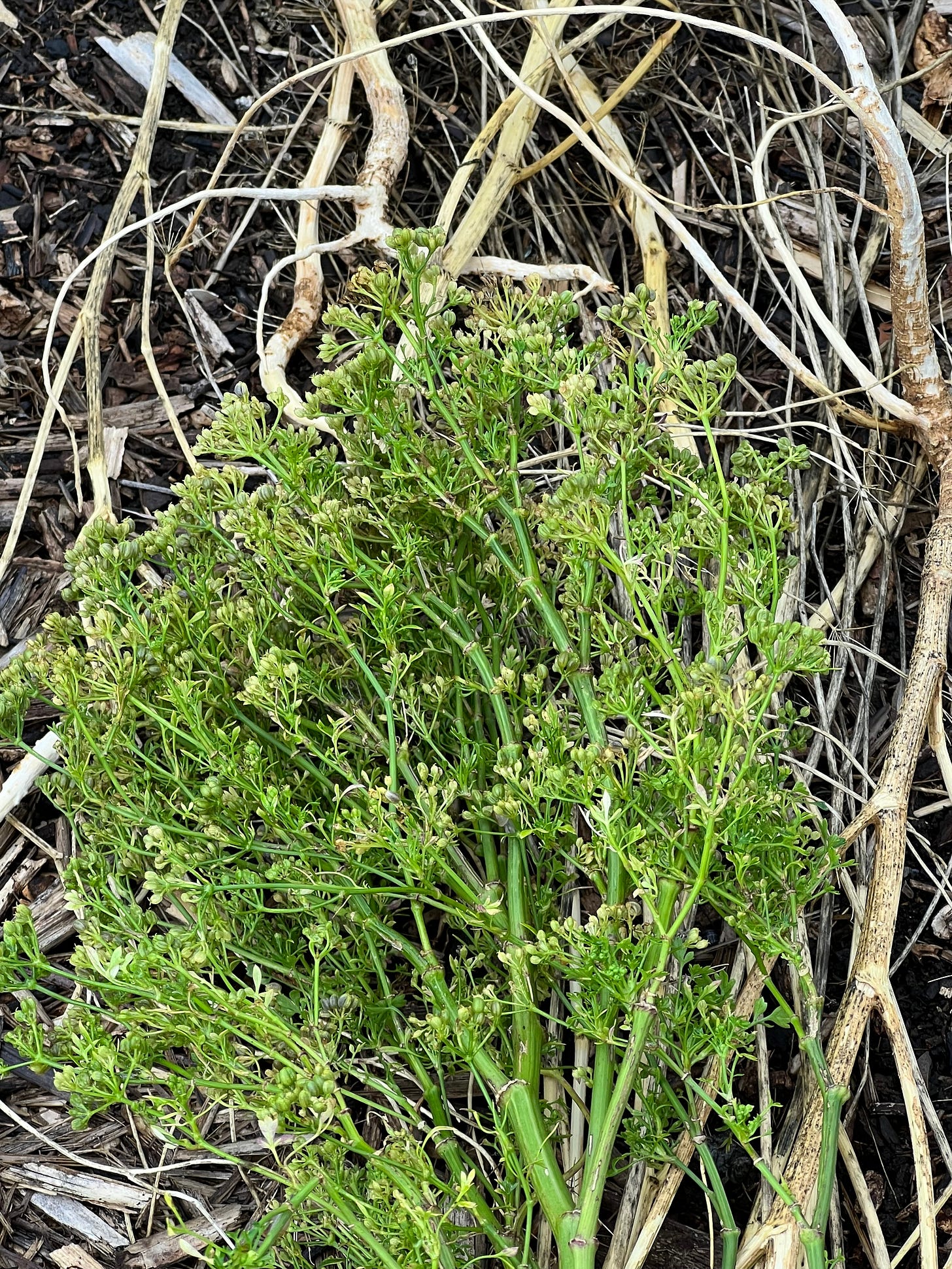
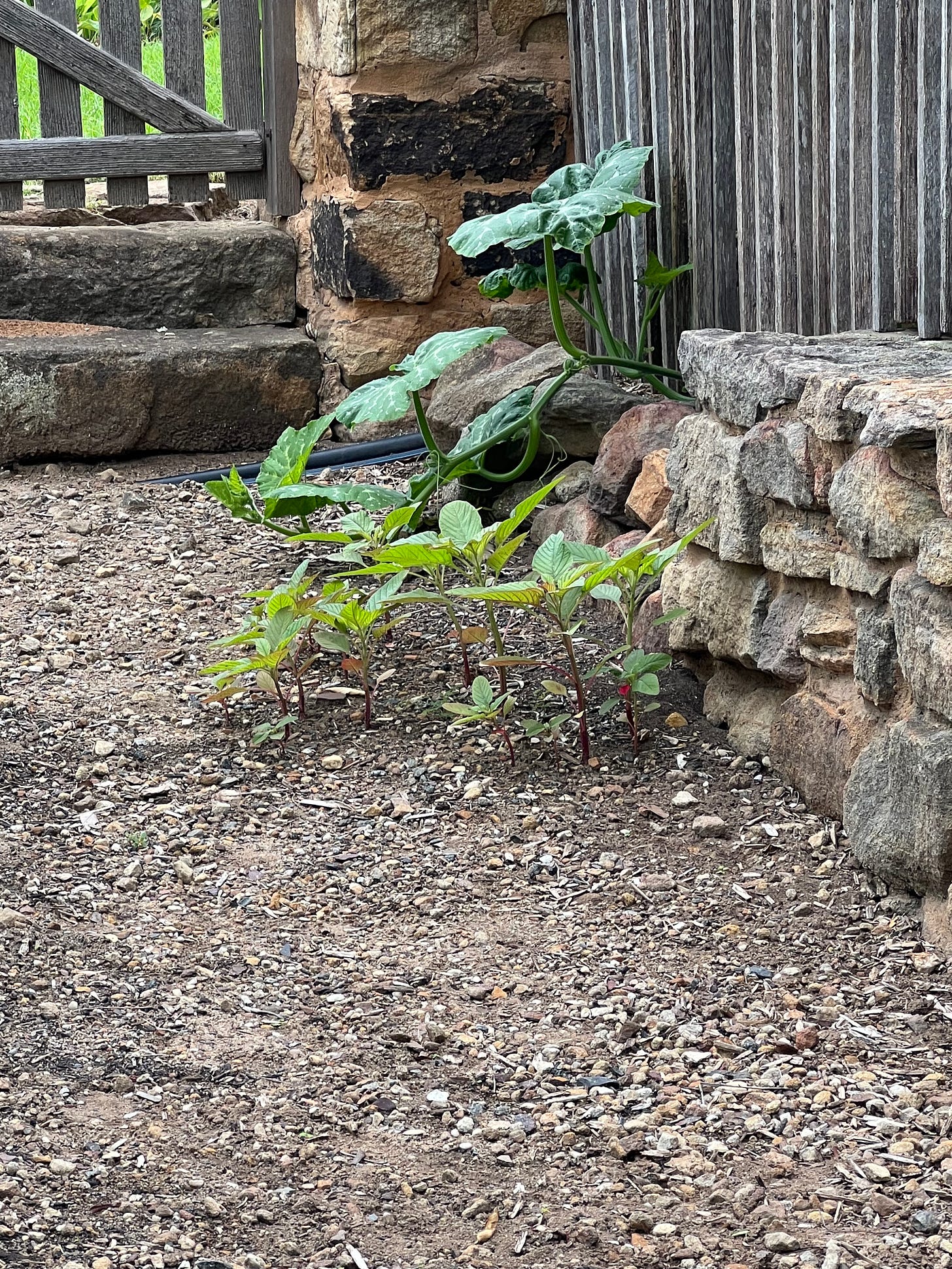
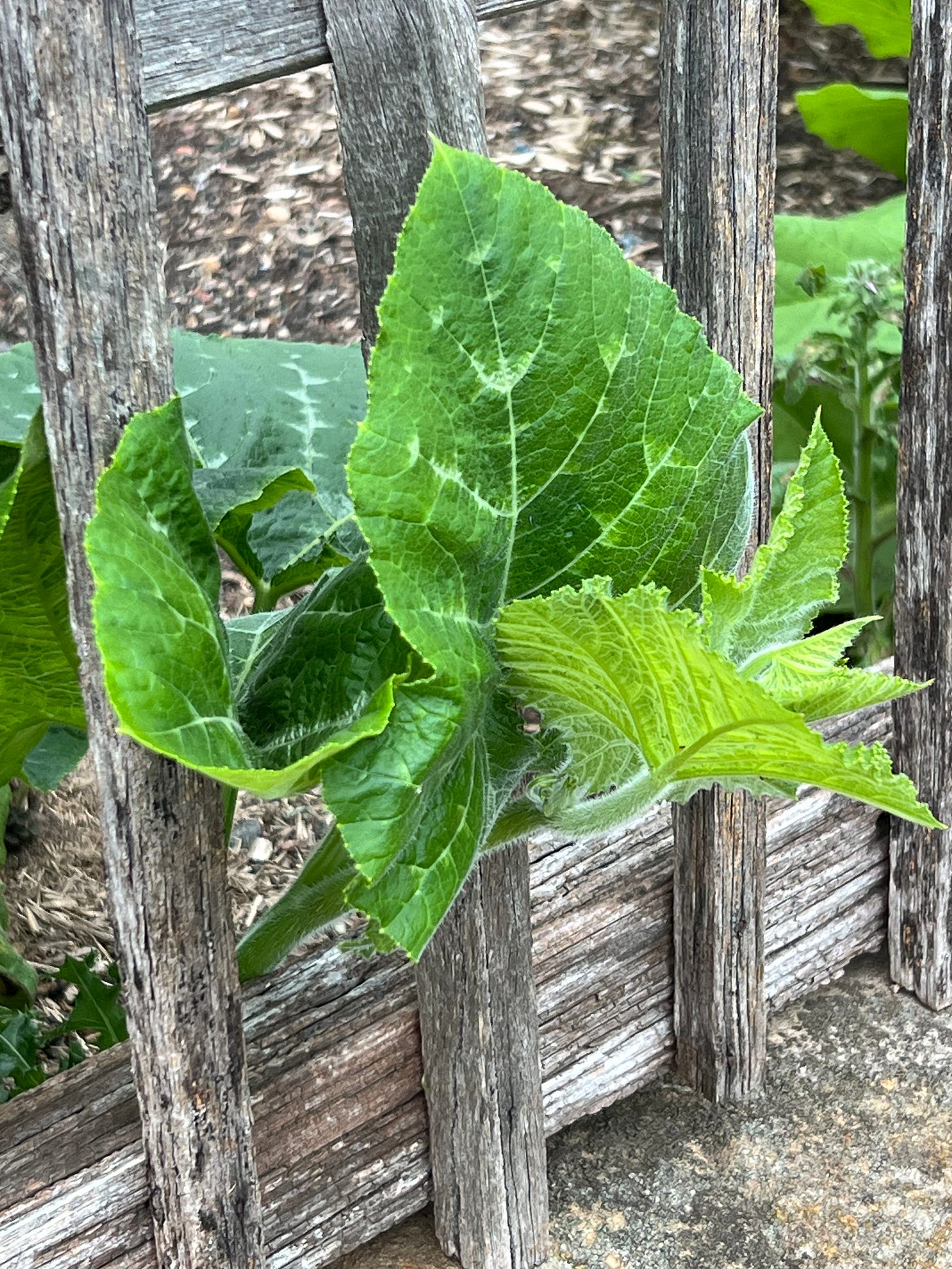
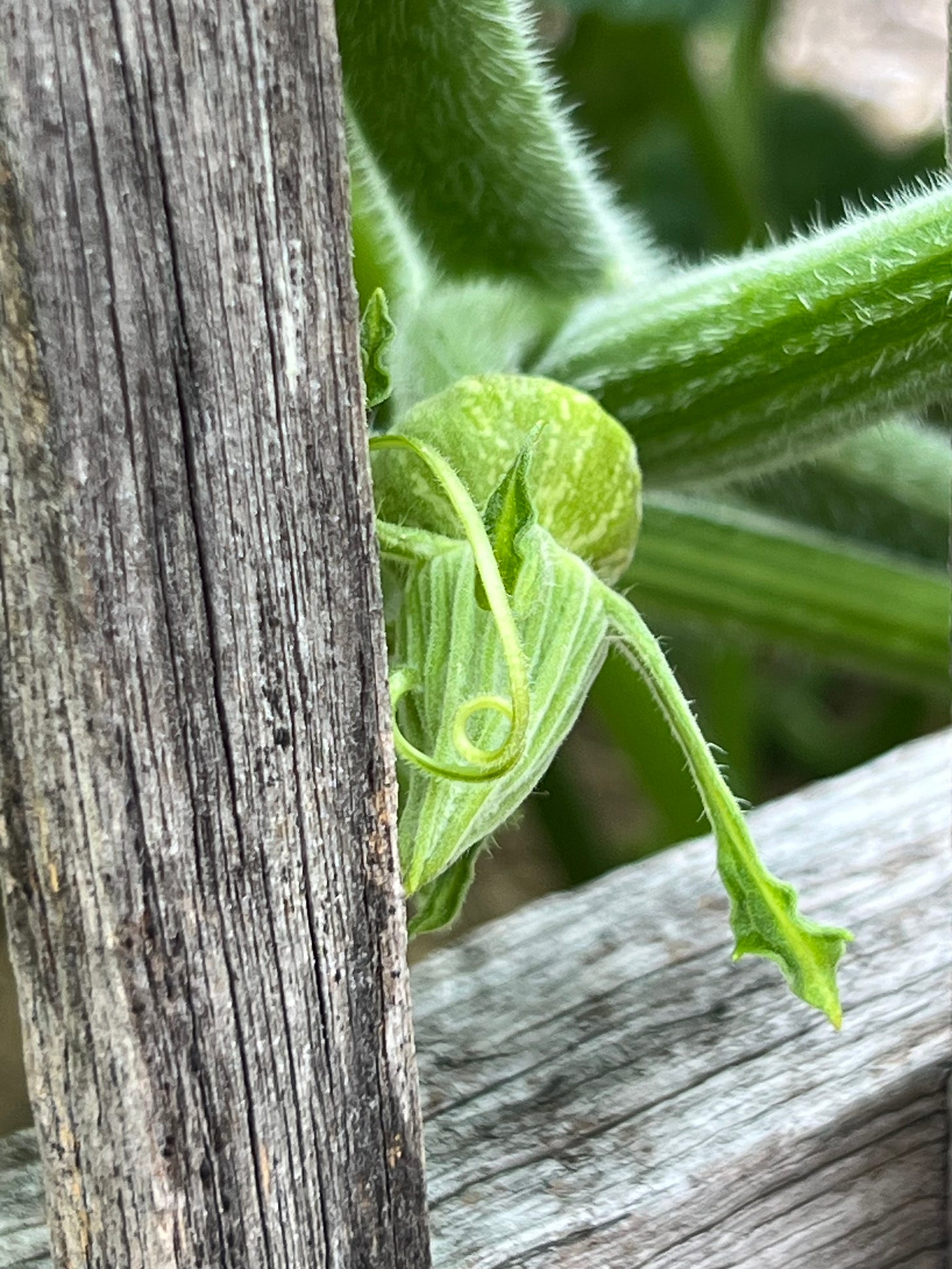
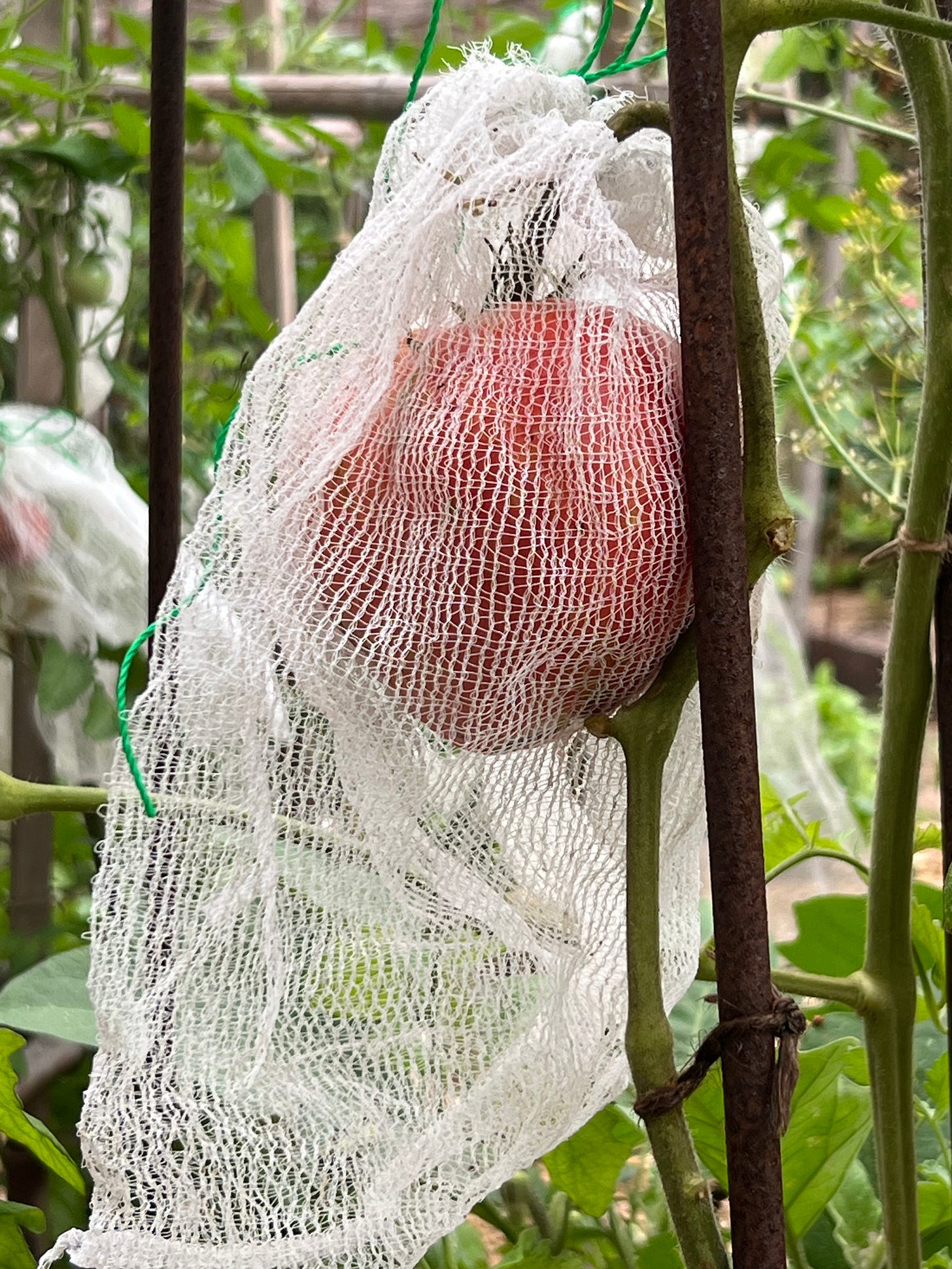
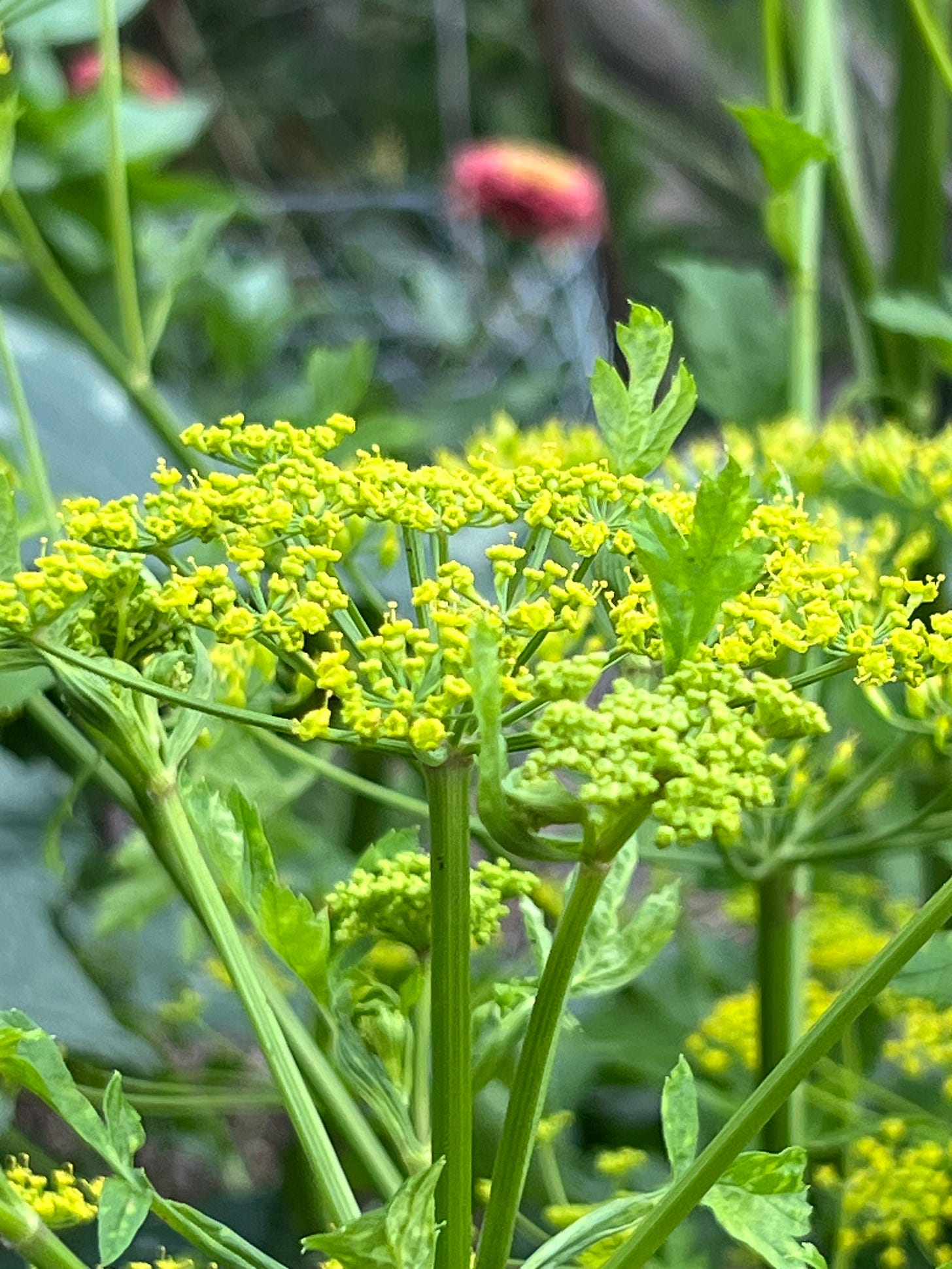
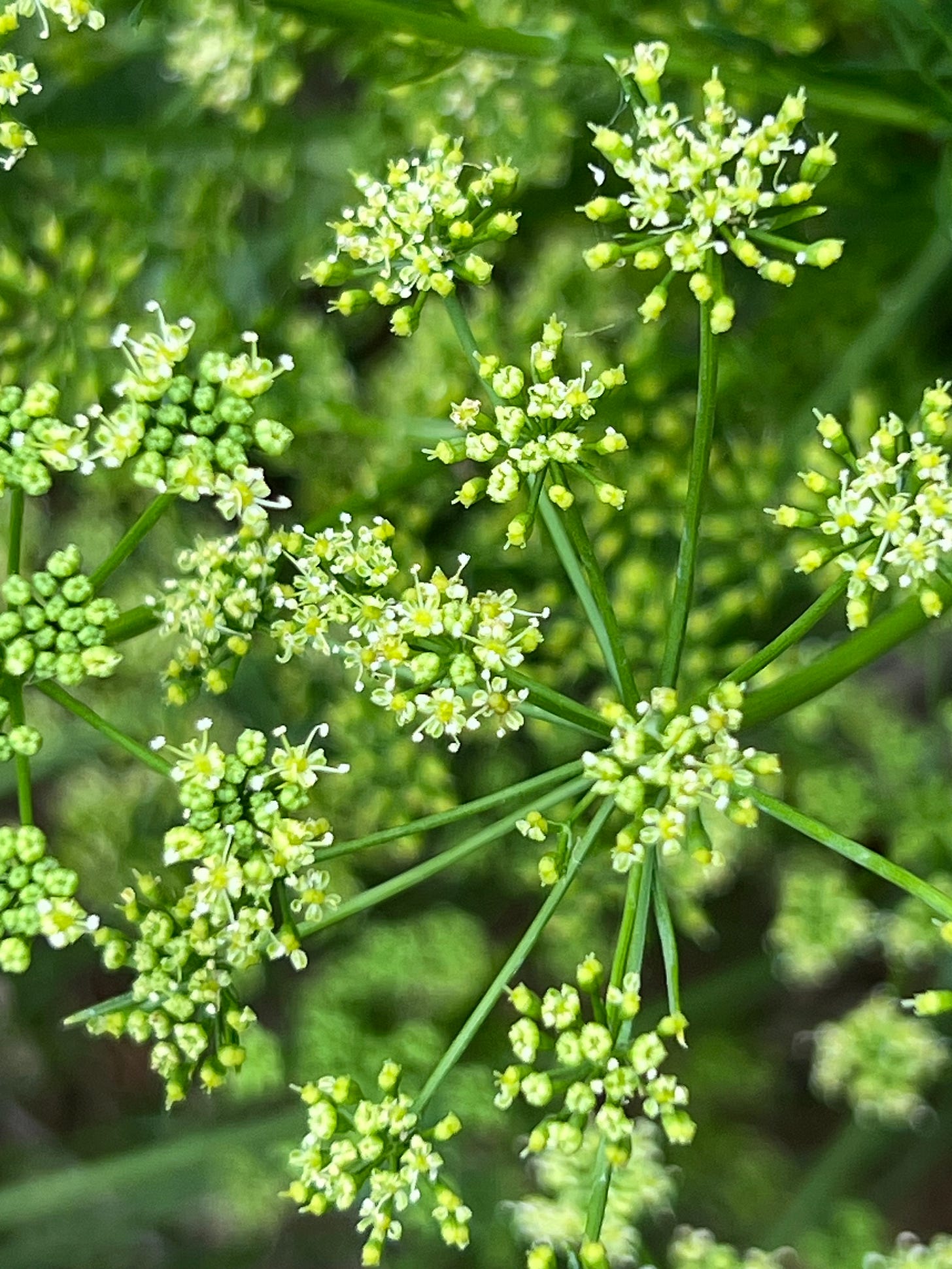
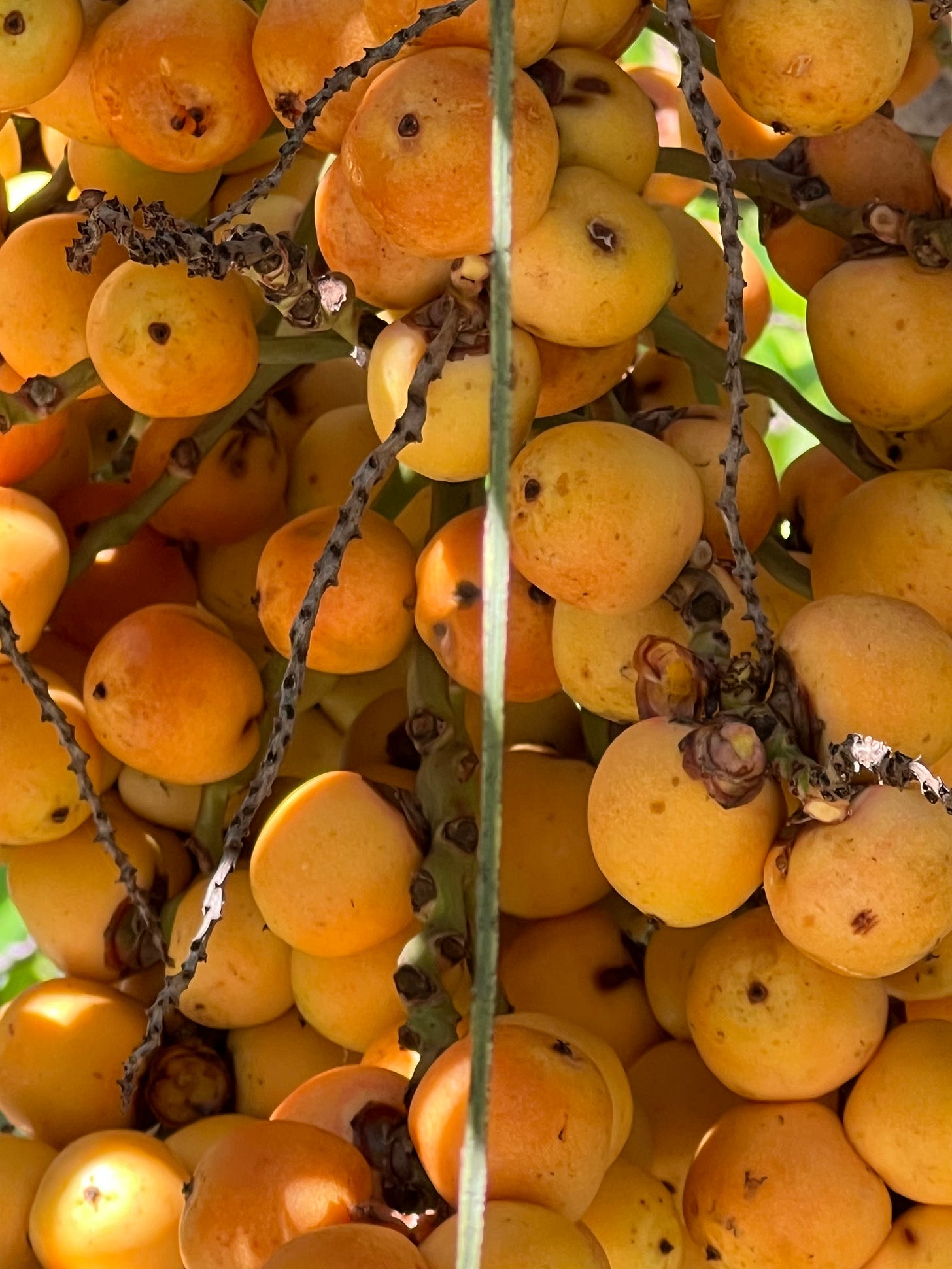

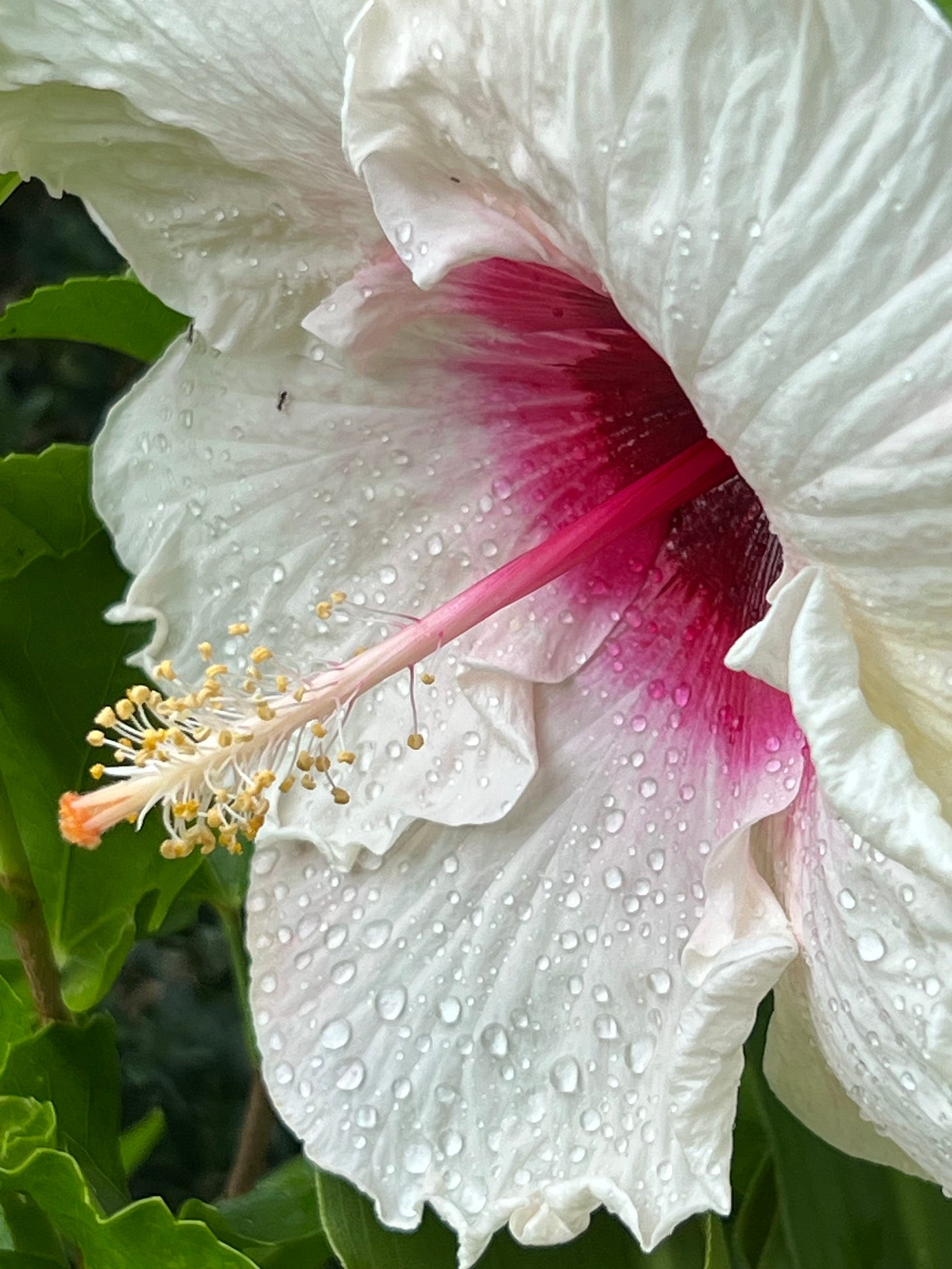
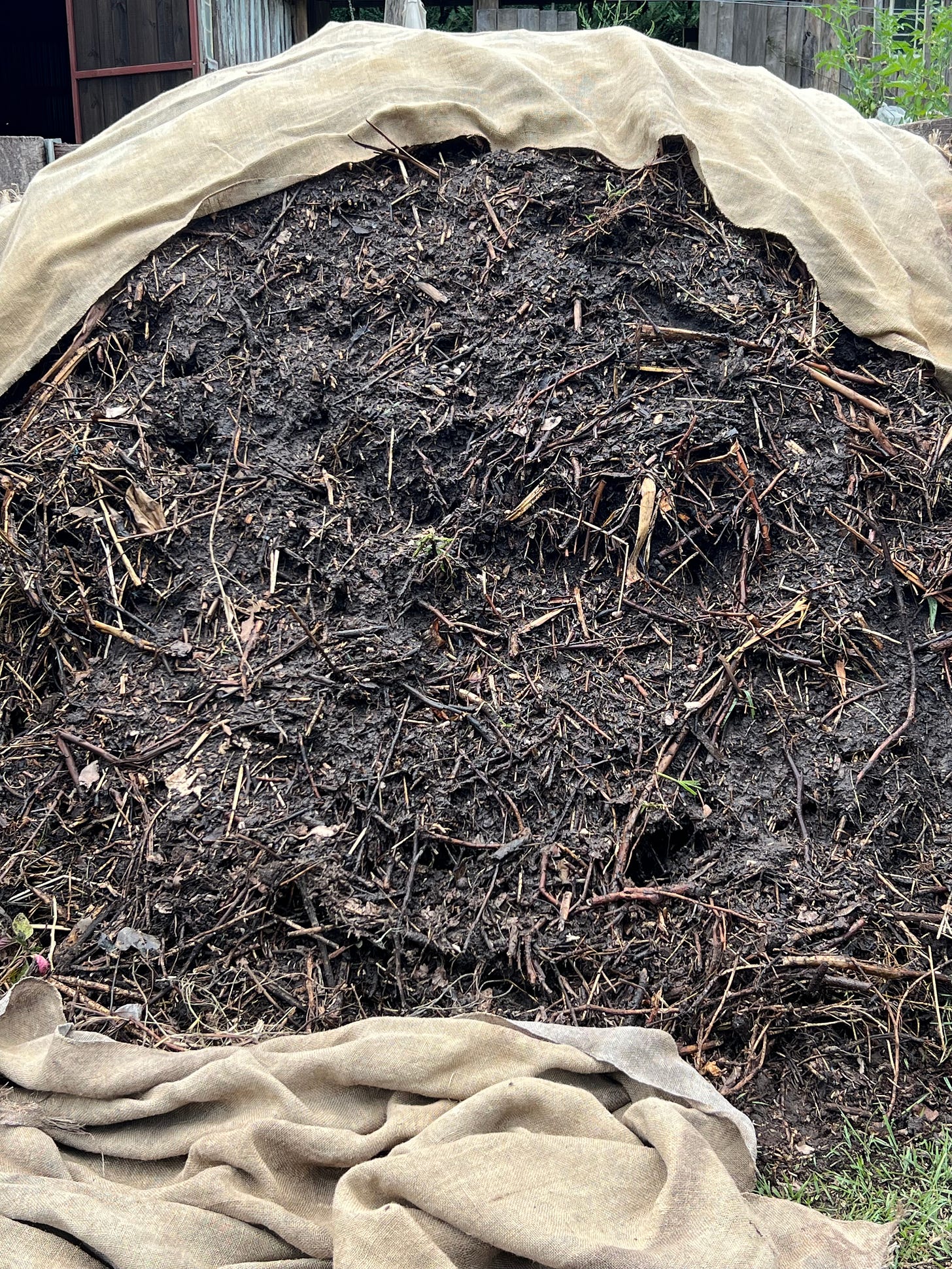
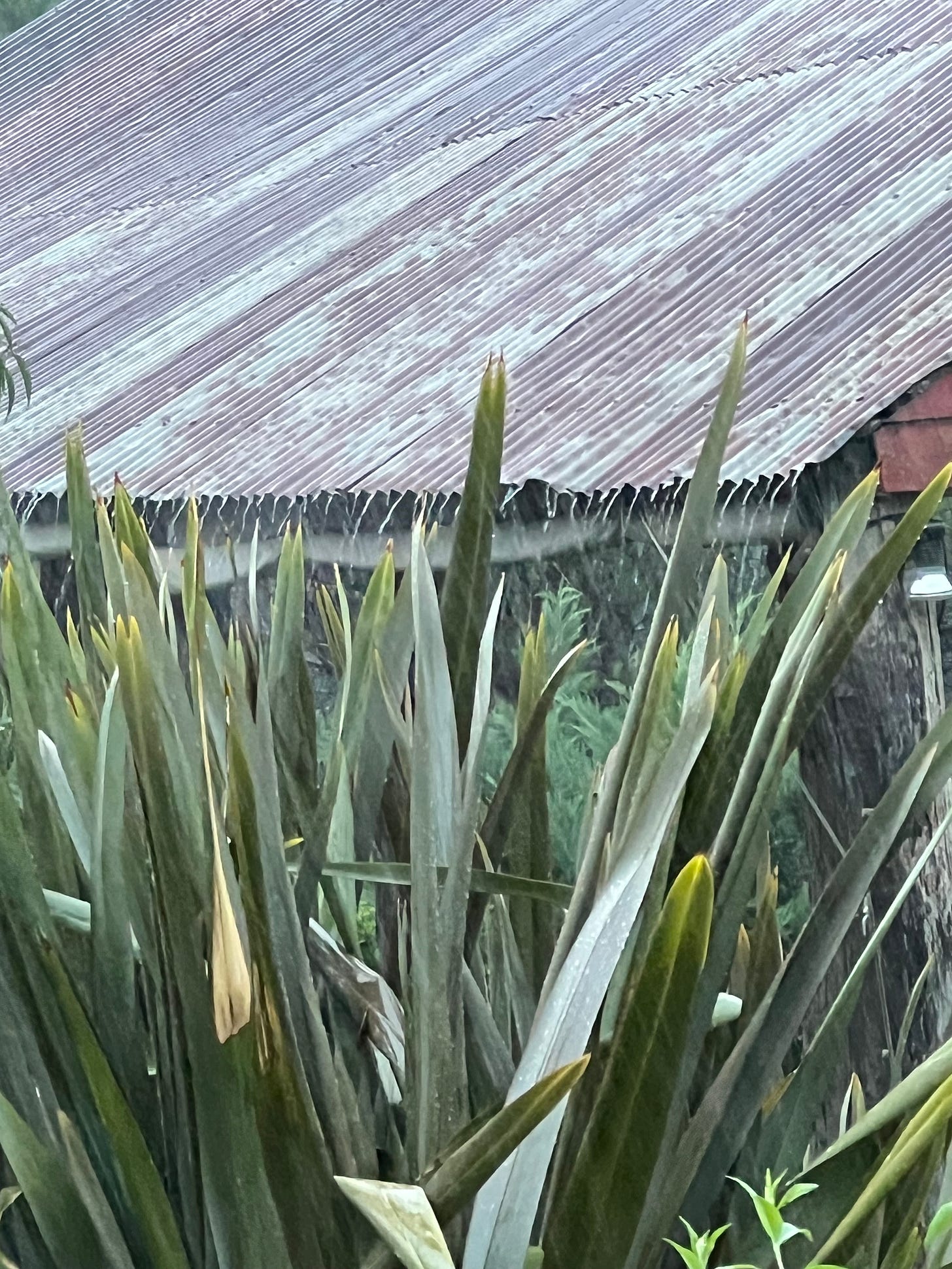
We have to watch those men who love 'tidying up' Sally! Can't tell you how many peeps over the years complain to me about their wisteria never flowering and we all know why!!! I'm guessing you are about to have a lovely lot of surprises pop up...they make my day and I know they will yours too. Mx
Like you, seed sowing either by hand or letting the plant do it’s own thing is often a wait and see. I picked the first flowers from the parsley knowing there is plenty left on the plants to just let the seeds do their thing, although the other day my husband was going to get into the garden to cut back the Marjoram and Irises and he asked about pulling out some parsley which had many ripe seed heads, so before he started I scattered them all over, now let’s see what happens. The Thyme self seeds everywhere as has the Mint the last couple of years, and lucky me, this year I have a vast number of Cyclamen which have planted themselves in a lovely big patch, I can’t wait for them to flower this year. Thank you for this weeks post.